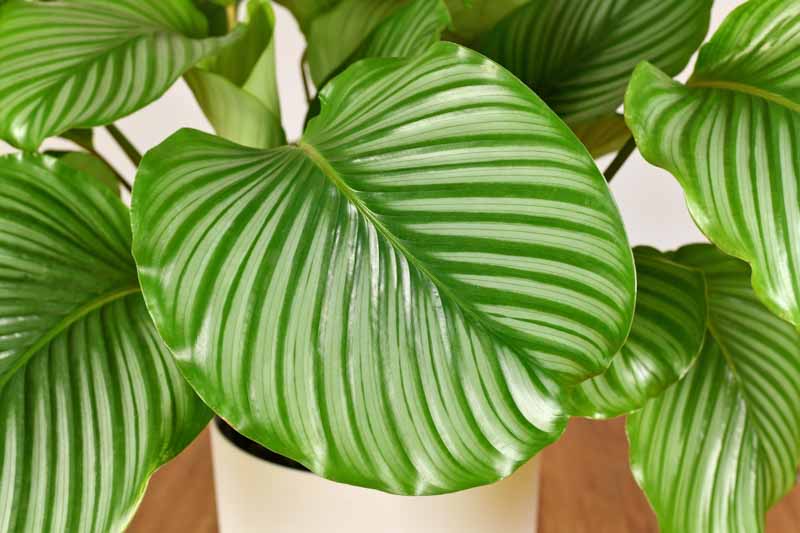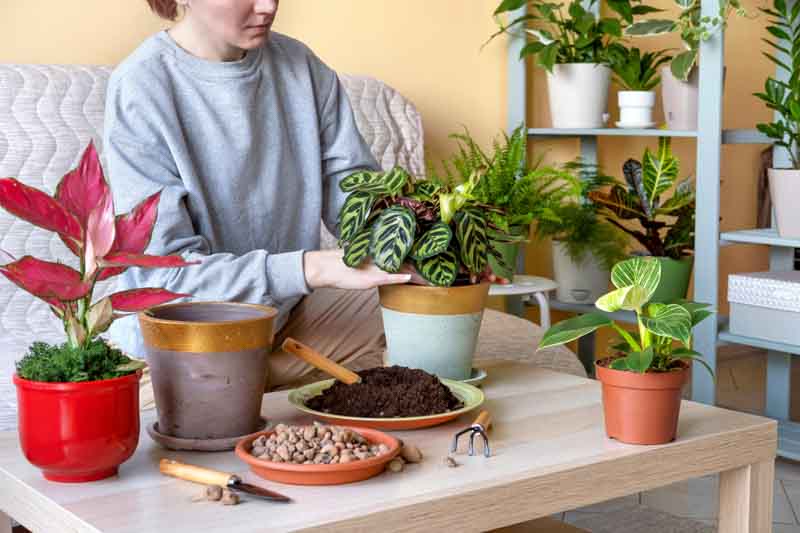Calathea rotundifolia, Goeppertia orbifolia, Goeppertia rotundifolia
Calathea orbifolia is a magnificent houseplant that brings beauty and a touch of the tropics to indoor settings. Its care requirements are straightforward, focusing on maintaining proper moisture, light, and humidity levels to ensure its lush foliage remains vibrant and healthy. This species, formerly assigned to Calathea, is now in the genus Goeppertia.
Calathea orbifolia is a strikingly beautiful houseplant known for its large, round, glossy leaves with bold silver-green stripes. Its foliage makes it a standout addition to any indoor plant collection, admired for both its aesthetic appeal and air-purifying qualities.
Native: This plant is native to Bolivia, where it thrives in warm, moist, and shaded environments of the forest floor, making it well-suited to indoor conditions that mimic its natural habitat. It belongs to the arrowroot family (Marantaceae), along with the Prayer Plant.
Plant Type and Habit: It is a perennial evergreen that forms dense clumps. Calathea orbifolia grows upright, with leaves emerging from the soil on individual stems, creating a lush, compact appearance.
Size: On average, Calathea orbifolia can reach about 2 to 3 feet in height (60-90 cm) and 1 to 2 feet in spread (30-60 cm), making it a medium-sized houseplant perfect for floor pots or large tabletops.
Flowers: While it can bloom under ideal conditions, its flowers are small, white, and not particularly showy compared to its stunning foliage. Indoor plants rarely flower.
Foliage: The plant’s large, round leaves are its most notable feature, with each leaf reaching a foot in width. The silver-green stripes on a dark green background are eye-catching.
Hardiness: Calathea orbifolia is hardy in USDA zones 11-12. It is not frost-tolerant and must be kept in environments above 60°F (15°C) to thrive.
Uses: Primarily used for decorative purposes, it enhances indoor spaces with its lush foliage. It’s also valued for its ability to improve air quality by filtering indoor air pollutants.
Toxicity: Calathea plants are non-toxic to cats, dogs, and humans, making them a safe choice for pet owners and families. Their sap may irritate sensitive skin.
Benefits: Beyond its visual appeal, Calathea orbifolia is known to contribute to a healthier indoor environment by purifying the air of certain toxins.

Caring for a Calathea plant involves specific steps to ensure it thrives in an indoor environment.
Light: Prefers bright, indirect light. Direct sunlight should be avoided to prevent leaf burn. Ideal near a window with sheer curtains or in a room with filtered light.
Soil: A well-draining potting mix is crucial. A good mix can be made of two parts peat/coir and one part perlite.
Water: Keep the soil consistently moist but well-draining to avoid waterlogging and root rot. Use distilled or rainwater to prevent leaf tip browning caused by fluoride in tap water.
Temperature and Humidity: Maintain indoor temperatures between 65 to 75°F (18 to 24°C), ensuring it does not drop below 60°F (15°C). Avoid temperature fluctuations and drafts. Requires high humidity levels to mimic its native tropical environment. Use a humidifier, mist the plant regularly, or place it on a pebble tray with water.
Fertilization: Fertilize monthly while actively growing with 1/4 strength, balanced fertilizer. Flush the soil several times per year to prevent salt build-up.
Pruning: Remove yellow or damaged leaves to encourage healthy growth.
Cleaning: Wipe leaves with a damp cloth to remove dust and help the plant breathe.
Repotting: Every two years or when the plant becomes root-bound. Use a fresh, well-draining potting mix during repotting.
Propagating a Calathea plant, like many other members of the Calathea genus, is best done through division. This method ensures that the new plants have a good start with established roots and foliage.
Choose the Right Time: The best time for propagation is in late spring when the plant is in its active growth phase.
Prepare Your Tools and Workspace: Ensure you have clean, sharp scissors or a knife, pots for the new plants, and appropriate potting mix (peat-based or similar to what the parent plant is in). Sterilize your tools with rubbing alcohol or a bleach solution to prevent the spread of disease.
Remove the Plant from Its Pot: Carefully take your Calathea plant out of its pot. You may need to tap the pot’s sides or gently pull the plant by the base to ease it out.
Inspect and Separate the Rhizomes: Look for natural divisions in the root ball where the plant has formed distinct clumps or sections. These are your propagation points. Gently tease the roots apart with your fingers or cut through them with your clean, sharp tool if necessary. Ensure each division has a good amount of roots and at least one or two shoots (leaves).
Pot Up the Divisions: Fill your new pots with a suitable potting mix, making a hole in the center for the division. Place each division in its pot, ensuring it sits at the same depth as in the original pot. Fill around the roots with more potting mix, gently firming to support the plant.
Water and Care for Your New Plants: Water each new Calathea plant thoroughly after potting to settle the soil around the roots and eliminate air pockets. Keep the soil consistently moist but not waterlogged. Place the new plants in a warm, humid spot with indirect light, similar to the parent plant’s preferred conditions.
Monitor and Maintain Humidity: To ensure high humidity, you can cover the pots with plastic bags to create a greenhouse effect. Ensure to open the bag daily for fresh air and check the soil moisture.
Be Patient: Growth may be slow initially as your Calathea plant adjusts and develops new roots and foliage. It can take several weeks to see significant growth.

Calathea orbifolia is relatively resistant to major problems, but like all indoor plants, it can encounter some pests, diseases, and common issues.
Spider Mites: These tiny pests can be identified by the fine webs they weave on the plant. They cause yellowing or speckled leaves. Increase humidity around the plant and wash it with a strong stream of water. For severe infestations, use insecticidal soap or neem oil.
Mealybugs: These white, cottony pests tend to cluster in leaf axils and under leaves, sucking sap and weakening the plant. Remove with alcohol-dipped cotton swabs or apply neem oil.
Aphids: Small, soft-bodied insects that can be green, black, brown, or pink, aphids typically feed in groups on the undersides of leaves. Combat them with a gentle spray of water, neem oil, or insecticidal soap to protect the plant’s health and appearance.
Scale insects: Hard or soft-bodied insects that attach themselves to the stems or leaves, causing yellowing and growth stunting. Scrape off with a fingernail or use a cotton swab dipped in rubbing alcohol. Insecticidal soap or neem oil may also be used.
Root rot: Often a result of overwatering, leading to brown, mushy roots and wilted leaves. Prevent by ensuring good drainage and letting the soil partially dry between waterings. Affected plants may need repotting with fresh soil after cutting away any rotten roots.
Leaf spot: Fungal or bacterial infections causing spots on leaves. Avoid wetting foliage when watering and improve air circulation. Remove affected leaves and treat with fungicides if necessary.
Brown Leaf Edges/Tips: Often a result of low humidity or fluoride in tap water. Use distilled water or rainwater and increase humidity around the plant.
Curling Leaves: Can indicate under-watering or too low humidity. Ensure consistent soil moisture and raise humidity levels.
Fading Leaf Color: Insufficient light can cause the vibrant patterns of Calathea orbifolia to fade. Provide bright, indirect light, but avoid direct sunlight, which can scorch the leaves.
Calathea orbifolia is known to be somewhat demanding due to its specific requirements for humidity, watering, and light. However, with attention to its care needs, it can be a rewarding plant to grow indoors.
Place your Calathea orbifolia in a spot where it can receive bright, indirect light. Avoid direct sunlight, which can scorch its leaves. A room with east or north-facing windows is ideal. Additionally, it thrives in high humidity, so consider locations like well-lit bathrooms or kitchens if humidity levels are higher.
Keep the soil consistently moist but not waterlogged, provide high humidity (above 60% if possible), maintain it in bright, indirect light, and ensure it is in a warm environment without drastic temperature changes. Use distilled or rainwater for watering.
Misting can help increase humidity around your plant, beneficial for mimicking its native tropical environment. Mist your Calathea orbifolia 2-3 times a week, depending on the ambient humidity in your home. During drier months, you may need to mist more frequently.
Calatheas, including Calathea orbifolia, are sensitive to the fluoride, chlorine, and other minerals found in tap water. These can accumulate in the soil and cause leaf tip browning. Using distilled, rainwater, or filtered water can prevent these issues.
Yes, trimming brown tips can help improve the plant’s appearance. Use clean, sharp scissors to cut just the brown edges, avoiding cutting into the healthy tissue. Addressing the underlying issues causing brown tips, such as adjusting watering practices or improving humidity, is also important to prevent further browning.
| Hardiness |
11 - 12 |
|---|---|
| Plant Type | Houseplants, Perennials |
| Plant Family | Marantaceae |
| Genus | Goeppertia, Calathea |
| Exposure | Partial Sun |
| Season of Interest |
Spring (Early, Mid, Late) Summer (Early, Mid, Late) Fall Winter |
| Height |
2' - 3' (60cm - 90cm) |
| Spread |
1' - 2' (30cm - 60cm) |
| Maintenance | Low |
| Water Needs | Average |
| Soil Type | Loam |
| Soil pH | Acid, Neutral |
| Soil Drainage | Moist but Well-Drained |
| Characteristics | Showy, Evergreen |
| Garden Uses | Patio And Containers |
| Hardiness |
11 - 12 |
|---|---|
| Plant Type | Houseplants, Perennials |
| Plant Family | Marantaceae |
| Genus | Goeppertia, Calathea |
| Exposure | Partial Sun |
| Season of Interest |
Spring (Early, Mid, Late) Summer (Early, Mid, Late) Fall Winter |
| Height |
2' - 3' (60cm - 90cm) |
| Spread |
1' - 2' (30cm - 60cm) |
| Maintenance | Low |
| Water Needs | Average |
| Soil Type | Loam |
| Soil pH | Acid, Neutral |
| Soil Drainage | Moist but Well-Drained |
| Characteristics | Showy, Evergreen |
| Garden Uses | Patio And Containers |
How many Calathea orbifolia do I need for my garden?
| Plant | Quantity | |
|---|---|---|
| Calathea orbifolia | N/A | Buy Plants |
Create a membership account to save your garden designs and to view them on any device.
Becoming a contributing member of Gardenia is easy and can be done in just a few minutes. If you provide us with your name, email address and the payment of a modest $25 annual membership fee, you will become a full member, enabling you to design and save up to 25 of your garden design ideas.
Join now and start creating your dream garden!
Create a membership account to save your garden designs and to view them on any device.
Becoming a contributing member of Gardenia is easy and can be done in just a few minutes. If you provide us with your name, email address and the payment of a modest $25 annual membership fee, you will become a full member, enabling you to design and save up to 25 of your garden design ideas.
Join now and start creating your dream garden!